Abstract
Working lands are (agri)cultural landscapes with natural value that provide tangible and intangible benefits to people. The development and loss of working landscapes and other rural lands have been increasing, especially in regions experiencing rapid urban growth. To address these issues and conservation needs, we conducted a multi-scale study that involved (1) an in-depth case study of a working ranch focused on conservation, and (2) a geospatial inventory of ecosystem services and cultural values across a Central Texas county that is still dominated by working landscapes yet is experiencing increasing urbanization. The purpose of these two complementary scales was to add a broader view of working landscape values by mapping the multiple benefits they provide and assessing where provisioning, regulating, and cultural benefits overlap. The ultimate objective of our study was to identify target zones for conservation planning. Based on categorical and spatial variation in the mapped benefits inventory, we identified four conservation target zones: Headwaters, Historic Towns, Geologic Significance, and Tourism Corridor. Finally, we framed these conservation target zones within the context of land use decisions and tradeoff analyses.
1. Introduction
At the turn of the millennium, agriculture covered about forty percent of global land area but is now decreasing in some regions like the United States (U.S.), largely at the expense of urban development [1,2]. From 1949 to 2012, the U.S. lost 772,950 km2 of agricultural lands and gained 210,437 km2 of urban lands [3]. The loss of agricultural lands to urbanization at regional scales has shifted the burden of food and fiber production from local areas with prime resources (e.g., soil, water) to foreign ecosystems not previously enlisted for direct human benefit [4]. The consequences of these land use changes, both globally and regionally, include climate change, reduced biodiversity, degraded water resources, poor air quality, and loss of rural economies and cultures [5,6]. Placing protected areas within urban environments helps mitigate these impacts [7,8], but urban protected areas are usually too small and too few to have measurable benefits [6,9].
Acknowledging the limitations of protected areas and the need for landscapes that work for both biodiversity and people, Kremen and Merenlender [6] have made the case for working lands conservation. Working lands are areas, typically privately owned, that are usually a mosaic of croplands, grazing lands, forests, and waterbodies that are managed for the sustainable production of food, fiber, forests, and fuel. Working lands provide critical resources, support rural economies, and offer wildlife habitat and a multitude of ecosystem services [10,11,12]. There are also heritage values that are unique to working lands, which would be lost with the loss of these multidimensional landscapes [13].
Inventorying and mapping of ecosystem services is increasingly being used for conservation planning and as a policy support tool [14,15,16]. An expansion of the ecosystem services concept—nature’s contributions to people (NCP)—“recognizes the central and pervasive role that culture plays in defining all links between people and nature” [17]. The NCP concept also elevates the role of local knowledge and regional contexts for evaluating trade-offs. A further adaptation of ecosystem services is the inclusion of relational values—the “preferences, principles, and virtues associated with relationships, both interpersonal and as articulated by policies and social norms” [18]. Inclusion of relational values identifies intangible features of a landscape that are important to our overall wellbeing and our responsibility to protect these intangible features [19,20]. With the addition of NCP and relational values to the ecosystem services framework, we hereafter use the term working landscapes to define and assess working lands as social–ecological systems (sensu [21]) where biophysical and social actors interact and share resources.
Methods for mapping provisioning and regulating ecosystem services are well established in conservation research [11,14,15]. Cultural ecosystem services and relational values have presented more of a challenge to inventory and map because they require local knowledge, and readily available datasets are rarely available [19,22]. Nevertheless, advances have been made in cultural landscape research [23], including working landscapes [24,25]. The need to document and map ecosystem services and cultural values for working landscapes is urgent, given the recent and rapid loss of working lands from urbanization [10,26]. And nowhere is this process more salient than in Texas.
Since 2000, Texas has grown faster than any other state in the USA, gaining more than 9 million new residents [27]. And currently, Texas has eight of the twelve fastest growing cities in the nation, all of them with greater than 9% growth from 2022 to 2023 [28]. This rapid expansion of urban areas has largely been at the expense of working lands [10,29]. Indeed, Texas is losing more than 400 hectares of working lands every day, which results in approximately USD 4.5 B of lost ecosystem services over a 20-year period [12,30]. Such rapid and widespread land use changes thus threaten the health of landscapes and the overall wellbeing of people. These impacts are heightened in Texas because it does not have many protected natural areas, less than 5% of its total land area [31]. Ensuring the future of working landscapes and the multi-dimensional benefits they provide remains a conservation challenge for Texas and beyond.
To address these issues and conservation needs, we conducted a multi-scale study that involved (1) an in-depth case study of a working ranch focused on conservation, and (2) a geospatial inventory of ecosystem services and cultural values across a Central Texas county that is still dominated by working landscapes yet is experiencing increasing urbanization. The purpose of these two complementary scales was to add a broader view of working landscape values by mapping the multiple benefits they provide and assessing where provisioning, regulating, and cultural benefits overlap. The ultimate objective of our study was to use this geospatial inventory and the resulting benefit maps to identify target zones for conservation planning.
2. Methods
2.1. Study Area
2.1.1. Gillespie County, Texas, USA
Central Texas is home to rural working lands and rapidly growing cities. The stretch of land between Austin and San Antonio along Interstate 35 has become a highly developed urban corridor now expanding westward into Texas Hill Country counties like Gillespie County (Figure 1). Proximity to urban areas, stagnant agricultural production, and rising land values have been the key drivers for working land conversions in Central Texas [10,29]. From 1997 to 2017, Gillespie County averaged a 5% increase in agricultural production value while land values rose by 390% over the same period [10]. The bucolic landscapes of Gillespie County, situated between Austin and San Antonio, make it particularly attractive for new commercial and residential developments.
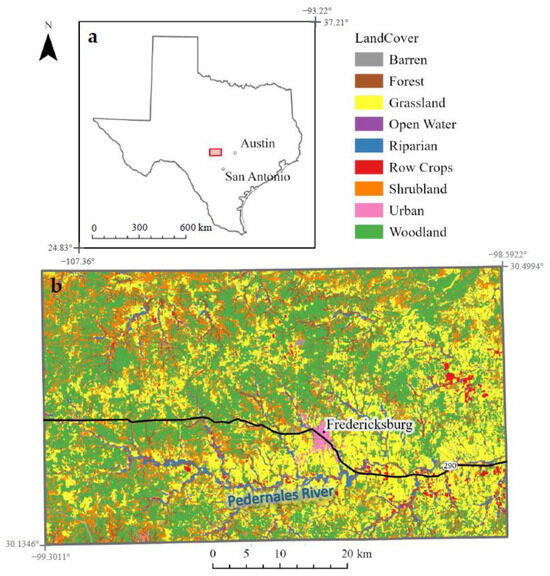
Figure 1.
Gillespie County study area (red rectangle) in Texas, USA (a) and land cover map of Gillespie County (b) using Ecological Mapping System of Texas [32].
As of 2024, Gillespie County (2748 km2) remains largely a working landscape, situated just beyond the high-density development to its east and south (Figure 1). It is almost entirely rural, with the town of Fredericksburg being the county seat and only incorporated community in the county. Fredericksburg and Gillespie County are best known for their peaches, wineries, and German heritage. These staples are tied to agricultural land uses and have a role in the cultural benefits we mapped: recreation, aesthetic enjoyment, sense of place, and tourism. The county also contains many historical markers, buildings, museums, and towns.
The agricultural, cultural, and historical resources of Gillespie County attract many tourists, but the top tourist attractions are wineries [33]. A recent proliferation of vineyards and wineries has made the Texas Hill Country the second most visited wine region in the nation [34]. While the price and quality of Hill Country wines may not be exceptional, the main attractor of this region is the natural and cultural landscape—a mosaic of rolling hills, grasslands, oak mottes, ranches, rivers, and unique geological features such as Enchanted Rock [35].
Wine, peaches, and other crops are integral parts of Gillespie County’s cultural landscape but take up a small portion of its land area. The vast majority of the county is used for ranching operations. Water needs are met primarily from groundwater, with the Edwards–Trinity aquifer being the principal source. Aside from food provisioning, the predominance of rangeland—a low-intensity agricultural land use—functions as habitat for a diversity of flora and fauna [36]. Abundant vegetation also contributes to soil protection, water quality, flood control, and climate and air quality regulation [12]. In sum, Gillespie County was selected for our study area because it is a working lands landscape that provides a multitude of benefits to both nature and society and is located within a broader region that is experiencing widespread and rapid land use changes.
2.1.2. Hershey Ranch
The Hershey Ranch, covering 623 ha, is the largest tract of protected land in Gillespie County (as of 2023) and is also a working ranch (Figure 2). The ranch has been managed by Texas conservationists, and the challenges it faces are related to working landscape conservation. A review of its recent history and interviews with land managers provided local knowledge on cultural and ecological conservation in this region. Data gathered for the case study on Hershey Ranch were sourced from public property and tax records, eminent domain proceedings, management documents, and ranch tours. For ecological landscape benefits, we reviewed challenges and responses from each of these sources, especially recurrent management priorities and grant-assisted improvement projects. These documents also informed cultural landscape benefits, which included an inventory of historical resources and a timeline of land use changes.
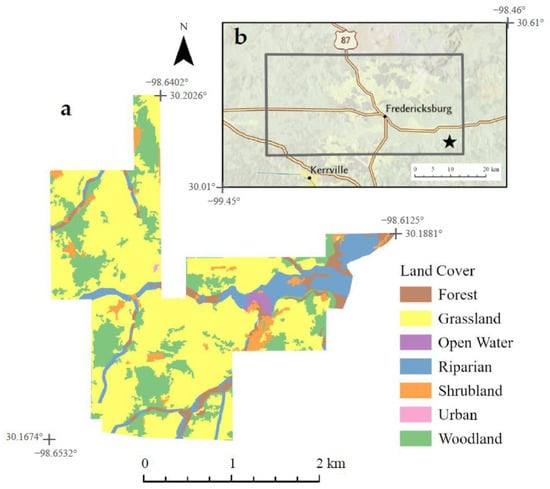
Figure 2.
The Hershey Ranch study area (a), located at the black star in southeastern Gillespie County (inner rectangle) (b). Land cover is mapped using the Ecological Mapping Systems of Texas [32].
Conservation issues and management goals were compiled and examined to inform a framework for mapping landscape benefits from the regional working landscape. Findings from the Hershey Ranch were incorporated into the framework used for the remaining stages of this study.
2.2. Conceptual Framework
Leveraging the nature’s contributions to people (NCP) framework, our study sought to improve the relevance of an ecosystem services (ES) geospatial inventory by using local knowledge and considering regional context. Accordingly, we began our analysis with the Hershey Ranch case study described in the previous section. Findings from this working-ranch-scale study were adapted to an existing ES framework [37,38] and expanded upon in the county-scale study, where a total of twelve contributions (hereafter benefits) were identified for our inventory classification (Table 1). In our classification, there are four benefits in each of the three ES categories: Provisioning, Regulating, and Cultural. The four cultural benefits we selected also encapsulate relational values.

Table 1.
Working landscape benefits classification (adapted from [37,38]).
Each benefit was mapped as binary (contributing or not contributing) using the best available data. We then overlaid benefit layers for each ES category. Thus, maps created for each ES category display an overlay of four benefits with values ranging from 0 to 4. Combining and overlaying the three ES categories created a full inventory of benefits ranging from 0 to 12. This binary, additive approach allowed for inclusivity and a broader set of opportunities to leverage for conservation.
2.3. County Inventory of Benefits
2.3.1. Data
Data for most benefits were obtained from public repositories as spatial datasets and included environmental, cultural, and ownership data at the parcel/site resolution. Many datasets were obtained as county-level files. All others were clipped to the county boundary. For environmental data, we used the Ecological Mapping Systems of Texas (EMST), which describes vegetation or land classes digitized from 10 m spatial resolution remotely sensed images [32]. EMST also allowed for a generalized land cover classification (Figure 1). Other environmental data used included the National Hydrography dataset (NHD, 1:24,000; [39]), ground water resources [40], and USGS digital elevation models (30 m resolution; [41]). Provisioning resource data were also obtained from the USGS Mineral Resource Data System [42].
Cultural data sources provided parks, major roads, mines, and historical designations. Parks and other protected areas were sourced from USGS Gap Analysis Project (GAP) Protected Areas Database (PAD-US 2.1) [31]. Two parks, LBJ National Historic Park and Enchanted Rock State Natural Area, straddled the county boundary and were intersected to retain the portion within Gillespie County. Park boundaries that were misaligned with parcels were adjusted to minimize overlay errors in the final analysis. The Texas Historical Commission’s (THC) Atlas database [43] provided many of the locations used to map cultural benefits, including national and state historical markers, historic places/properties, museums, cemeteries, and courthouses. Locations for some cultural resources were identified from the Fredericksburg Convention and Visitor Bureau [33]. We used the major roads from Texas Department of Transportation Roadway Inventory [44] to assist with cultural resource mapping.
Our analyses relied on parcel-level (e.g., individual working ranches) datasets obtained from Gillespie Central Appraisal District (CAD) [45]. Parcels were provided as a shapefile, and land type descriptions as a spreadsheet in an appraisal export. Primary mapping products pertaining to agricultural use required a merge of both datasets. The parcel shapefile was further utilized in combination with point locations to map mineral resources, as well as several cultural benefits. Parcel geometry was also used to map conservation easements. Though most underlying data were sourced from publicly accessible spatial databases, manual location identification was required for conservation easements. Each was mapped by matching recorded legal descriptions to tax parcels in a shapefile sourced from Gillespie CAD.
All data used in our study were projected into a uniform spatial reference and spatially analyzed as vector data with ArcGIS Pro 3.0.3. Area calculations, in hectares (ha), were recorded for each sublayer, layer, and successive mapping output. At the single benefit level, layers were mapped as binary. For benefits mapped using multiple sublayers containing feature overlap, sublayers were dissolved or merged into a single layer for area totals. For overlap counts of benefits (Table 1), totals and maps were generated using the count overlap geoprocessing tool.
2.3.2. Provisioning Benefits
Habitat. Map products created for habitat included managed lands and parcels of eligible size for a wildlife use appraisal (8 ha minimum). The managed lands database was compiled from protected areas, conservation easements, and tax parcels appraised for wildlife use in 2021. Public protected areas, referred to here as parks, were obtained from USGS PAD-US 2.0 [31].
Though the PAD-US includes conservation easements listed in the National Conservation Easement Database, none were listed in Gillespie County. Instead, conservation easements were obtained through Gillespie County Clerk’s public records search web service. Searching the names of known land trusts yielded twelve conservation easements with information from which tax parcels were located and mapped. These parcels and additional 2021 tax roll information were obtained from Gillespie County CAD downloads [45].
In addition to parks and conservation easements, parcels appraised for wildlife use were mapped as providing habitat. Properties with agricultural use appraisals, obtained from 2021 tax roll data, were selected if coded for wildlife use. Qualifying properties were merged with parcels using the property ID identifier contained in each dataset. A managed lands layer was created by combining parks, conservation easements, and wildlife use parcels using a merge tool.
The final addition to the habitat database consisted of parcels of eligible size (>8 ha) and land cover for a wildlife use appraisal. These were included to reflect the potential for habitat management rather than only those actively managed. Lastly, areas were removed where developed/urban land cover, as outlined by EMST, overlapped habitat sublayers.
Food and Fiber. The layer for food and fiber provisioning contained land classes used for farms (row crops) and ranches (grasslands). The USDA 2017 census of agriculture for Gillespie County [46] revealed that almost the entirety of the county is classified as working lands. By selecting row crops and grassland for the food and fiber provisioning, some food and fiber production is likely excluded because many ranches graze livestock on shrubland. Though the vast majority of land area is devoted to agriculture, this approach likely captured areas not producing food and fiber products, such as grasslands/livestock used for aesthetics/pleasure. The row crops layer was created by selecting lands listed as row crops from the EMST dataset, and the grassland layer by filtering all EMST land classes that matched a grassland subtype.
Raw Materials. The provisioning of raw materials was mapped to contain mineral resources. Though the landscape’s provisioning of fuel and building materials is evident in historical records and likely continues at the property scale, mineral resource data provided a publicly accessible means to model this benefit. Pits, mines, and quarries were mapped using data from Mineral Resource Data System [42]. The dataset, downloaded for Gillespie County, contained point locations that were then merged with an intersecting parcel. The association between parcels and point locations was verified using aerial imagery (Esri World Imagery) and parcel ownership data. All point locations occurred on or near a visibly barren area, with some spread across multiple parcels. In cases where mines were near parcel boundaries and contained consistent ownership names, additional parcels were added to the layer.
Freshwater. Locations providing freshwater were mapped using area aquifers representing groundwater resources [40]. Areas with access to groundwater were selected to represent this benefit, but the principal source of surface water, the Pedernales River, is captured by the aquifers’ geographic extent (Figure A1). Though the Pedernales River is allocated for some public and private use, Gillespie County relies primarily on groundwater [47]. No surface water prospects are considered for meeting future water demand [48]. Spatial data for the major and minor aquifers were obtained as separate layers from the Texas Water Development Board [40]. Each was then clipped to the county boundary and subsequently merged to create a map of freshwater provisioning.
2.3.3. Regulating Benefits
Climate and Air Quality. Climate and air quality regulation was mapped from a single layer containing vegetated land. Though different vegetation types vary in contribution to this benefit, any vegetation is assumed to have a beneficial impact when compared with unvegetated land. Using the EMST database, the vegetation layer was created by selecting and removing land classes that did not describe vegetation, such as open water, barren, or developed.
Water Quality and Flood Control. Vegetation in riparian areas slows water runoff, filters pollutants, and promotes infiltration, thus contributing to both water quality and flood control. This benefit was mapped by creating a layer from the EMST dataset for all vegetated classes coded as riparian.
Soil Protection. All undisturbed vegetation was selected to map soil protection. This required a filter to remove classes from the EMST dataset that lacked vegetation or represented a disturbance. Removed classes included row crops, water, barren, and grasslands described as disturbed.
Pollination. This map focuses on the habitat of pollinators that benefit existing farms. The criteria for this benefit considered vegetated land within a 3 km radius (typical foraging distance for bees) of farms [49]. A 3 km buffer zone was created around existing farms, represented by row crops. Areas within the buffer were then removed if not covered by the undisturbed vegetation layer in EMST. Finally, the layer representing all vegetation was intersected with the buffer layer, removing those areas within the defined distance but lacking vegetation.
2.3.4. Cultural Benefits
Recreation. Recreation layers were created to represent hunting, golf, horseback riding, fishing, hiking, and other outdoor activities available at parks. Most of these were identified through Fredericksburg Convention and Visitor Bureau’s website and intersected with associated parcels. Public recreation locations in semi-natural areas were mapped using the PAD-US [31]. The ecosystem service of recreation is often associated with activities provided by public lands; however, private working landscapes host some of the same opportunities. While Gillespie County is known for hunting exotic and native game, publicly accessible data on private hunting leases are more difficult to access. Though it is largely a private affair, parcels with wildlife use indicate likely locations. Parcels identified as wildlife use were filtered and separated into one of the layers for this benefit.
Aesthetics. For scenic resources, this study mapped working lands that were visible from a major road. Working lands were defined and mapped as parcels with an agricultural exemption. A viewshed analysis was performed to distinguish visible locations. The viewshed was created through a geoprocessing tool that required observer points and an elevation surface raster. Observer points were generated at 0.4 km intervals along the main roads provided by the Roadway Inventory database [44]. For the elevation surface, we used a 30 m digital elevation model [41].
Sense of Place. We used historical resources identified from the Texas Historical Commission’s Atlas database [43] and included museums, cemeteries, historical markers, and locations listed in the National Register (NR) of Historic Places. Museums and historical markers were provided as point layers. Point locations were used to select parcels associated with the museum or content in the historical marker. For some historical markers, associated parcels could not be identified and were left out. Cemeteries and NR properties were provided as a polygon layer and used directly in the final sense of place map.
Tourism. The Fredericksburg CVB website and parcels with an orchard use provided data for mapping tourism. A point database was created from Fredericksburg’s CVB website [33], which contained 112 county-wide listings with multiple attraction types. Of the original 112 points, 93 locations were used to map tourism. Cinemas, bowling alleys, lodging, and scooter rental shops were among the 19 removed locations. Remaining points identified museums, orchards, wineries/vineyards, and farms offering tours.
2.4. Mapping of Conservation Target Zones
The design of this research included three progressive stages, where the results from the second and third stages depended upon the findings of the previous stage. The first stage was a case study of conservation at the ranch level, which aided in local knowledge and the development of a region-specific framework for mapping landscape benefits relevant to conservation. From the initial framework, twelve binary benefit layers (Table 1) were selected and mapped at the county level and constitute the broad spatial inventory stage (stage 2). Finally, categorical and spatial variation were assessed to create conservation target zones useful for conservation planning and tradeoff analyses.
Conservation Target Zones were mapped by using place knowledge gained in the creation of this inventory and assessing regional differences in landscape benefits. Differences included high and low overlap values, as well as disparities among ES categories. Since these were used to provide a context for viewing trade-offs relevant to working lands conservation, development threats were also considered. In some cases, vulnerable benefits, or those with a high potential to generate conservation support, were deciding factors.
3. Results
3.1. Hershey Ranch Local Knowledge
Land use and management of the 623 ha tract that is now Hershey Ranch (Figure 2) have varied over the course of its history. The seven parcels contained in the property have been consolidated since at least 1976, and conveyances suggest that livestock was among its earliest agricultural land uses. As early as 1860, there were mentions of cotton farming, an endeavor that was likely short-lived, and ranching became the primary land use for much of its known history. Since the recording of a conservation easement in 2009, the focus shifted to wildlife habitat. This focus coexisted with cattle grazing for the following 9 years until cattle were removed to allow pastures to recover. Funding and labor have been focused on a variety of conservation projects that improve conditions beneficial to wildlife and provide ecosystem services. Such projects included brush removal, erosion control, and promotion of native forbs and grasses in previously improved (non-native) pastures.
Water supply was another challenge discussed by management at the Hershey Ranch. Most of the county relies on groundwater, and no groundwater well had been drilled at the Hershey Ranch. Commissioning such a project was deemed expensive and counter to the vision of Hershey Ranch. Without crop operations, water demands were relatively low, and domestic needs were met by a rainwater collection system and a small lake. Persistent drought conditions reduced the surface water available to potential livestock. These developments dissuaded management from reintroducing cattle. Until water supply conditions improve, the benefit of the use of cattle would be considered only in the overall habitat quality needs of the ranch.
The most contentious conservation issue at the Hershey Ranch was eminent domain from utility companies. Though protected through a conservation easement from development or subdivision, certain areas of the property were condemned on two occasions: once in 2014 for an electric transmission line and once in 2019 for a natural gas pipeline. After these two losses, Hershey Ranch management learned that before approving utility routes for eminent domain, the Public Utilities Commission of Texas (PUCT) must consider factors such as recreational and park areas, historical and aesthetic values, and environmental integrity. With this new knowledge, a broad inventory of cultural resources was taken at the Hershey Ranch to obtain a historical designation from the Texas Historical Commission. Though the primary land management goal was focused on improving natural resources, Hershey Ranch managers sought to protect natural resources by leveraging cultural resources. This broad inventory approach informed our county-scale spatial inventory.
Aside from inspiring a framework, the Hershey Ranch study informed the methods and data used to map nature’s contributions to people at a regional scale. The first insight was to include a suite of cultural resources in the mapping inventory. After noting multiple land uses common to the area (Figure 1 and Figure 2), it was evident that the Texas 1-d-1 wildlife use valuation could be used to map recreation and habitat. Other management activities informed the list of landscape benefits and included soil protection, water quality, water supply, and pollination, as they were the most emphasized and supported by project grants.
3.2. County-Scale Benefits
3.2.1. Provisioning ES Benefits
Habitat. Gillespie County is covered by three Omernik Level 4 ecoregions: Balcones Canyonlands, Edwards Plateau Woodlands, and Llano Uplift [50]. The Ecological Mapping Systems of Texas (EMST) included 55 classes of ecosystems for the county (Figure 1). These ecoregions and ecosystems provide habitat for a wide variety of wildlife. Land mapped as providing habitat totaled 247,828 ha, covering 90% of Gillespie County and spanning throughout the highly vegetated rural county. Wooded and forested land made up the majority (50%) of this area, followed by grassland (28%), shrubland (15%), and riparian (4%).
Areas lacking habitat occurred near Fredericksburg and rural subdivisions (Figure 3) and included developed land classes and parcels less than the 8 ha minimum area (Figure A2). Managed lands (Figure A3) were prime wildlife habitat and consisted of conservation easements (1790 ha; Figure A4), parks (593 ha; Figure A5), and 1-d-1 wildlife use lands (27,688 ha; Figure A6). In all, the habitat covered 247,828 ha (90.2% of the county).
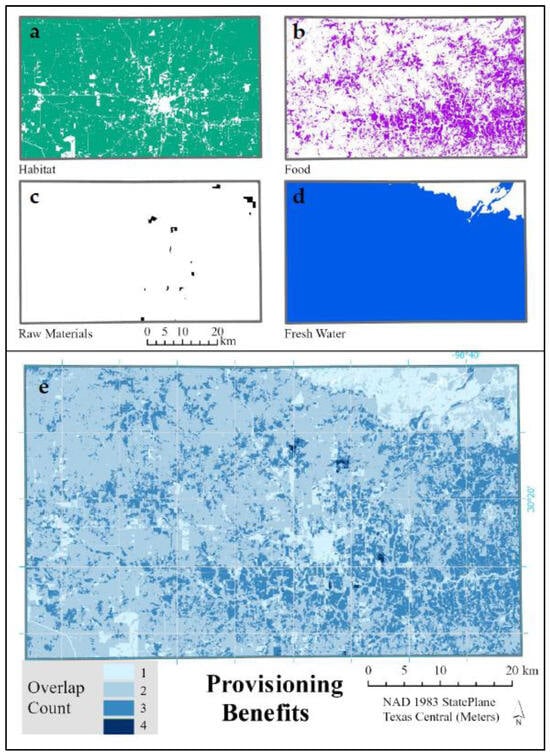
Figure 3.
Provisioning ES benefits overlay maps of Gillespie County. Small maps on top show land contributing to habitat (a), food/fiber (b), raw materials (c), and freshwater (d). Large map on bottom displays the overlay of these benefits with values representing overlap counts (e).
Food and Fiber. Though 93% of Gillespie County participated in an agricultural use valuation, food and fiber provisioning totaled only 30% (82,988 ha) with the methods used here. Since many agricultural operations do not produce food or fiber, this study relied on the land classes of row crops (4930 ha) and grassland (78,055 ha) (Figure A7). Row crop land uses in Gillespie County produced vegetables, grains, hay, fruits, and tree nuts. The fruit and tree nut category ranked highest in sales, with peach and pecan orchards as prominent land uses. For rangelands, the dominant land use was cattle ranching with 46,570 cattle. There were also 28,103 sheep and 22,664 goats that generated USD 3,517,000 worth of wool, mohair, and milk. Overall, food and fiber provisioning from ranches and farms concentrated near the Pedernales River and its tributaries (Figure 3).
Raw Materials. Raw materials parcels contributed 1680 ha, making up 1% of the county area (Figure A8). Materials extracted included sand, gravel, talc, gypsum, barium, and feldspar. Talc, barium, and feldspar extractions were secluded to the northeast corner of Gillespie County, and the remaining majority consisted of stone and sand extraction pits.
Freshwater. Only the northeast corner of Gillespie County lacked a groundwater supply, with the rest of the county (93%) having potential access to water. Major aquifers (Trinity and Trinity–Edwards) covered 89% of the county, and minor aquifers (Hickory and Ellenburger–San Saba) covered 92% (Figure A1, Figure A9 and Figure A10).
The entire area of Gillespie County contained at least one provisioning benefit, and 88.5% of the county area contained two or more benefits (Figure 3, Table 2). Land with two provisioning benefits had the highest coverage at 63%, while land portions with three provisioning benefits accounted for 24% of the county. Less than 1% contained all four provisioning benefits. These rare occurrences took place where mineral extraction (raw materials) occurred on agricultural parcels that provided habitat and were underlain by an aquifer. Provisioning benefits were lowest in the northeast corner, where access to freshwater (via an aquifer) was absent. The lack of access to groundwater was somewhat counterbalanced by rarer raw materials, both owing to local geology. Outside of the water-scarce northeast, the more abundant resources of gravel, sand, and stone formed an arc around the eastern half of Fredericksburg’s developed region. Habitat and food/fiber also filled areas around the central developed region, each varying in spatial pattern. The provisioning of food or fiber was most consistent along the Pedernales River, increasing towards the eastern part of the county. Food and fiber provisioning was less discriminant than habitat for patches of development.

Table 2.
Overlap of provisioning benefit layers in Gillespie County.
3.2.2. Regulating ES Benefits
Climate and Air Quality. Grassland, woodland, and all other vegetation contributing to climate and air quality regulation covered 99% of the county (271,095 ha) (Figure 4 and Figure A11). The non-contributing portion (1%) occurred in patches that lacked vegetation, such as near Fredericksburg, rural developments, and major roads. Non-contributing patches also occurred south of the Pedernales River and near the eastern county line.
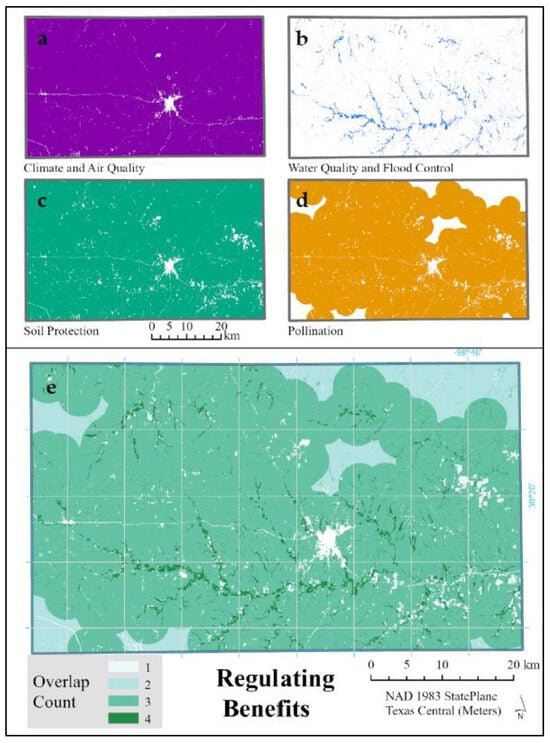
Figure 4.
Regulating ES benefits overlay maps of Gillespie County. Small maps on top show land contributing to climate and air quality (a), water quality and flood control (b), soil protection (c), and pollination (d). Large map on bottom displays the overlay of benefits (e).
Water Quality and Flood Control. Regulation of water quality and flood control mapped from riparian vegetation covered 12,165 ha (4.4% of the county). This benefit map reflects the 30 m buffer used by EMST to define areas as riparian (Figure A12). Riparian vegetation common to Gillespie County includes grasses and herbaceous vegetation, bald cypress trees, live oak mottes, and black willows. The regulation of water quality and flood control from this vegetation occurred along streams throughout the county, but large concentrations occurred on the Pedernales River and its tributaries (Figure 4).
Soil Protection. Soils in Gillespie County are a combination of mollisols, alfisols, inceptisols, and entisols. The most abundant, molliosols, occur across the savanna grasslands of the Edwards Plateau and are mostly threatened by overgrazing livestock and wildlife [50]. Thick alfisols (over 178 cm) cover the floodplains and valleys that support most of the crop production in Gillespie County. The two less suited to cultivation and cattle grazing, inceptisols and entisols, support (and are protected by) different types of vegetation. Local inceptisols result from weathered granite, a rock type confined to the Llano Uplift. Entisols are unconsolidated sediments covering limestone slopes in hilly regions. At 266,155 ha, or 97% of the county, soil protection had the second highest aerial coverage among regulating benefits (Figure 4). Non-contributing patches occurred where vegetation was absent (barren or urban) or classified as a disturbed type (Figure A13).
Pollination. For pollination, 87% of the county (239,859 ha) was mapped as contributing (Figure 4). The 3 km buffer surrounding row crops (Figure A14) was highly vegetated (97%). Barren and developed land within the zone totaled 8555 ha and was removed. Large non-contributing areas were confined to urban locations or those far from row crop land uses. These areas were most notable north of Fredericksburg and along the northeastern and southwestern corners of the county.
For aggregated regulating ES benefits, the maximum overlap count of four benefits covered 4% of the county (Figure 4, Table 3). An overlap of three benefits had the most coverage at 83%. The lower counts of 0 or 1 benefits only covered 3% of the county. The western half of the Pedernales River watershed, where there was a higher concentration of headwater streams, contained the highest concentrations of the maximum overlap. High overlap values also occurred along riparian areas where development and cultivation were sparse. Areas with the lowest values included large patches in the northeast and southwest corners of the county. Land devoted to farming (row crops) only provided climate and air quality regulation, and therefore had lower overlap values. Other low-value patches were areas that lacked riparian vegetation or proximity to a farm.

Table 3.
Overlap of regulating benefit layers in Gillespie County.
3.2.3. Cultural ES Benefits
Recreation. There were 28,627 ha (10%) of recreational lands spread throughout Gillespie County (Figure 5). Of this area, the majority was from hunting (27,688 ha; Figure A6), followed by parks (593 ha; Figure A5). Prominent parks included Lady Bird Johnson Municipal Park, LBJ National Historic Park, LBJ State Park, and Enchanted Rock State Natural Area. Other private recreation, such as golf, fishing, and horseback riding, contributed the least to land area, only 246 ha (Figure A15 and Figure A16).

Figure 5.
Cultural ES benefits overlay maps of Gillespie County. Small maps on top show land contributing recreation (a), aesthetics (b), sense of place (c), and tourism (d). Large map on bottom displays the overlay of benefits with values representing overlap counts (e).
Aesthetics. Scenic lands—agricultural lands visible from a major road (Figure A17 and Figure A18)—totaled 159,478 ha (58% of county area). These scenic benefits were most prominent in eastern Gillespie County and were absent in areas with topographic obstructions or few major roads (Figure 5). Scenic resources covered a variety of landscapes including stream-cut canyonlands, rolling hills, grasslands, and oak mottes.
Sense of place. The sites of historical resources (historical markers, museums, National Register (NR) properties, historic sites, and cemeteries; Figure A19, Figure A20, Figure A21, Figure A22 and Figure A23) were many, but covered a relatively small area totaling 916 ha (Figure 5). One reason for the small areal coverage was that there was a lot of overlap among sublayers. The scattered historic cemeteries contributed the least area, with only 28 ha. The NR properties contained several schools and homesteads on small parcels but also contributed the large Fredericksburg Historic District (118 ha) and Lyndon B. Johnson National Historical Park—Ranch Unit (75 ha). The Admiral Nimitz State Historic Site (1 ha) neighbored Fredericksburg’s Historic District (FHD), where resources were densely packed and overlapped considerably. The FHD contained three out of the seven museums, and resources here and elsewhere were often accompanied by a Texas Historical Marker (Figure A19). Many of the sense of place benefits were clustered around small towns such as Harper, Crabapple, Cherry Spring, and Luckenbach.
Tourism. The footprint of wineries, vineyards, orchards, and other attractions selected for tourism totaled 5974 ha (2% of county area; Figure A24). Isolated patches occurred throughout the county but concentrated along the Pedernales River (Figure 5). Like sense of place, tourism resources occurred near towns, but there were also large contributions in rural areas from orchard land uses (Figure A25) and farms offering tours. While the recreation, aesthetic, and sense of place features mentioned above also contribute to tourism, they were not double counted for this ES category.
Of all ES categories, cultural resources had the smallest aerial coverage, leaving 37% of the county bare of cultural benefits (Figure 5). One benefit was most common at 54% (Table 4). A count of two benefits covered 8%, and three benefits covered less than 1%. Patches of the county with the highest overlap values (n = 3) were well dispersed. Although cultural benefits existed in undeveloped regions with low visibility, areas with no contributions were generally far from towns and otherwise not visible from one of the major roads (Figure A17). The highest densities of cultural benefits occurred in the southern half of Gillespie County.

Table 4.
Overlap of cultural benefits in Gillespie County.
3.2.4. Summation and Summary of Benefits for Gillespie County
The combination of all provisioning, regulating, and cultural benefits had a potential maximum overlap count of 12, one for each layer. The entire county was mapped as providing at least one benefit, and the maximum value attained was nine benefits (Table 5). Extreme values were uncommon and only occurred where highs or lows were consistent across benefit categories (Figure 6). The highest values were concentrated along the Pedernales River (largely from provisioning and regulating benefits) and State Highway 290 (largely from cultural benefits). This region also contained many of the isolated patches of high values (eight or nine benefits), highlighting locations with many overlapping benefits (e.g., LBJ National Historic Park). The part of the county with the lowest total value was the town of Fredericksburg (Figure 6). For the most part, this highly developed area only produced the one benefit of tourism. The northeast corner of Gillespie County had relatively low overlap values, with most of this region only providing the three benefits of habitat, climate/air quality, and soil protection.

Table 5.
Overlap count of all benefits in Gillespie County.
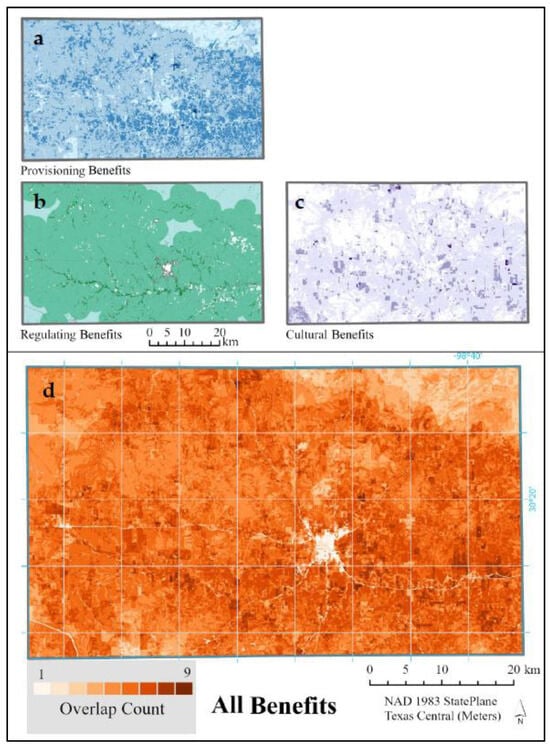
Figure 6.
Summation of all benefits for Gillespie County. Small maps on top created from overlays of provisioning (a), regulating (b), and cultural benefits (c). Large map on bottom displays the overlay of all benefits with values representing overlap counts (d).
Most of the county was mapped between these extremes, where moderate values (between five and seven) covered 85% of Gillespie County (Table 5). Widespread average values were accounted for by several layers with high aerial coverage (Table 6). Among these are the benefit layers for habitat, freshwater, climate/air quality, and soil protection, each of which covered more than 90%. Of the other eight layers, most covered a much smaller area. Sense of place, raw materials, water quality/flood control, and tourism each covered less than 5%. The coverage disparity occurred between layers and categories. For provisioning benefits, two layers had coverage over 90%, while raw materials only covered 1%. Regulating benefits had the most expansive footprint, with three layers covering more than 87% of the county. Conversely, the cultural benefit category had two layers covering less than 3% of the county. The cultural benefit with the greatest area was aesthetics (via landscape scenery), covering 58% of the county.

Table 6.
Areal coverage of landscape benefits inventory.
3.3. Conservation Target Zones
Based on physical geography, natural resources, cultural resources, development patterns, and overall landscape benefits (Figure 6), four conservation target zones were derived (Figure 7): Headwaters, Historic Small Towns, Geologic Significance, and Tourism Corridor.
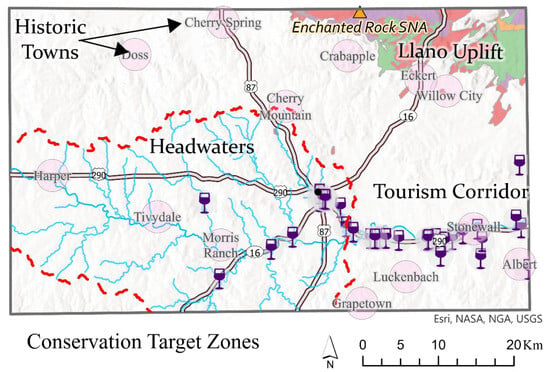
Figure 7.
Conservation Target Zones. Zones are divided into Historic Towns, Geologic Significance (Llano Uplift), Tourism Corridor, and Headwaters. Historic Towns (n = 13) are marked by pink circles. Geologic Significance is marked by the colored geologic layers of the Llano Uplift and Enchanted Rock State Natural Area (orange triangle). Tourism corridor is marked by wineries and vineyards (purple wine glasses) along major highways. Headwaters of the Pedernales River Watershed are marked by major streams (blue lines) and the upper watershed boundary (red dotted line).
Zone derivation began where overall landscape benefit values were highest. Though some patches of high overlap were dispersed through the county, the majority were concentrated around the Pedernales River and its tributaries. These were more abundant along eastern portions and especially in cultural and provisioning benefit categories. The Tourism Corridor was most distinguished from the Headwaters by the abundance of tourism benefits (Figure 8). Of the tourism sublayers, wineries and vineyards were particularly dense east of Fredericksburg (Figure 7). In terms of regulating services, the Tourism Corridor contained large patches of low overlap values (Figure 6). Conservation in this zone concerns the impacts of high development pressure, sustainability issues concerning the wine industry and traditional land uses, and the role of scenic resources.
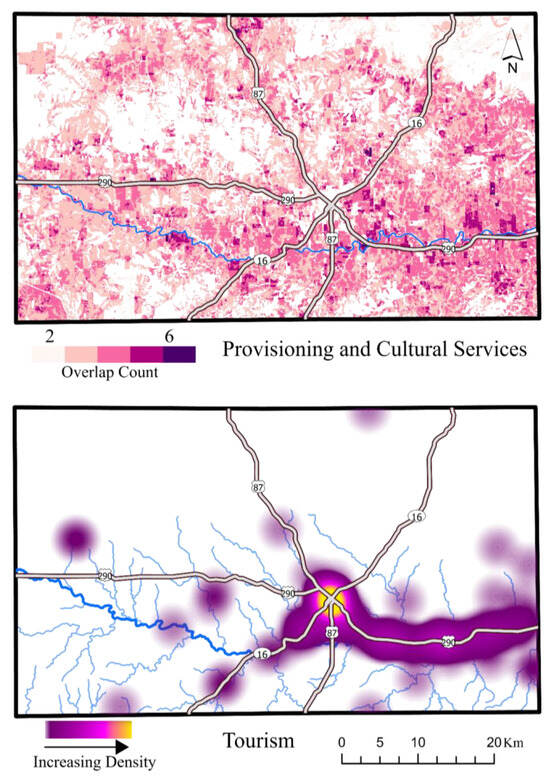
Further upstream, development pressure is on the rise but lower than the Tourism Corridor. For the Headwaters zone, recreation and ecological conservation were identified as targets (Figure 9), and water quality and flood control benefits presented an opportune benefit for leverage. The Headwaters zone, mapped with a moderate resolution Hydrologic Unit Code boundary (HUC-10), had high regulating values and fewer low-value patches (Figure 9). Because of the high stream density and less intensive land uses, conservation in this zone also has implications for water supply. As managed lands encompassed recreation, protection of recreation on private ranches was noted as an additional incentive for conservation in the Headwaters zone.
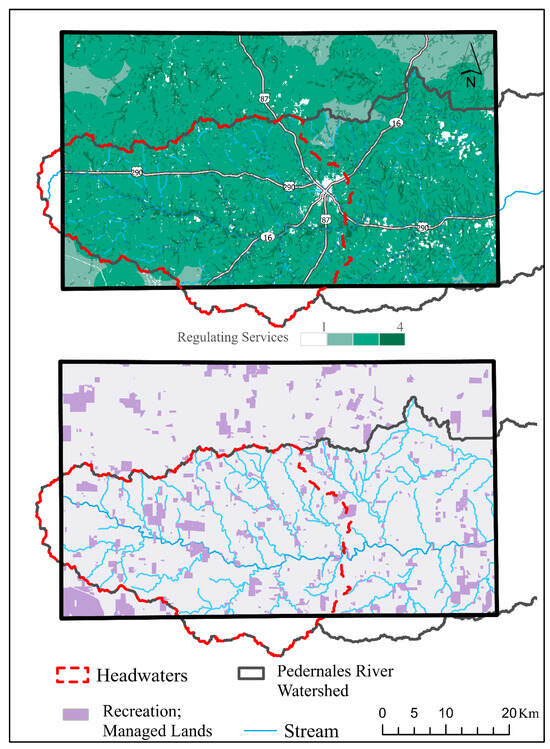
Figure 9.
Headwaters zone derivation. Top map shows Headwaters zone where regulating values are high and intact relative to the rest of the county. The bottom map shows recreation and managed lands (wildlife use exempt parcels, parks, and conservation easements).
The Geologic Significance zone around the Llano Uplift was distinguished by low values across benefit categories (Figure 10). The geology and lack of groundwater had a restricting influence on some landscape benefits in this zone, but were most lacking in measured cultural benefits. Those absent from the provisioning and regulating categories reflected sociocultural values. Raw materials were the main exception as they were comparatively abundant. In terms of conservation potential, ecological benefits were high in this zone. Considering the absence of services, especially groundwater access, the lack of development pressure also defined this zone. Conservation targets here were identified as natural resources, as opposed to cultural resources.
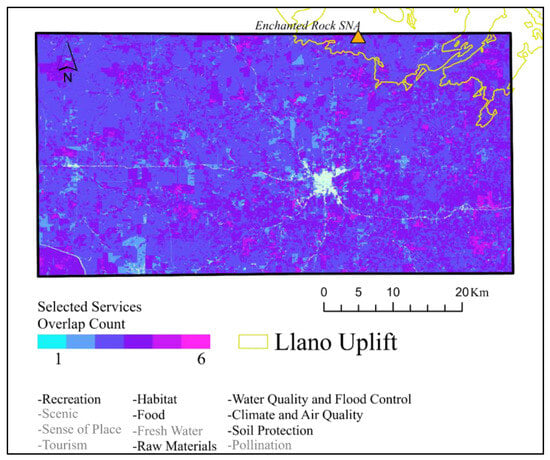
Figure 10.
Derivation of the Geologic Significance zone around the Llano Uplift. Map of Gillespie County with selected benefits mapped. When the sociocultural benefits are removed, the Llano Uplift Zone (yellow) compares with the rest of county. Enchanted Rock State Natural Area (orange triangle), of the same geology, is also shown.
As opposed to the other three conservation target zones, Historic Small Towns was derived from noncontiguous areas (Figure 11). Outside of the Tourism Corridor, these small towns captured many of the isolated hubs of high cultural values. This was especially true for sense of place benefits. Many of these small ranching and farming communities or ghost towns had a school listed in the National Register of Historic Places and/or historic churches. Historical resources with official designations were assumed to have some measure of protection, and their loss was less concerning than historical resources without a designation. Outside of Fredericksburg, we designated thirteen historic small towns based on their high concentrations of cultural values.
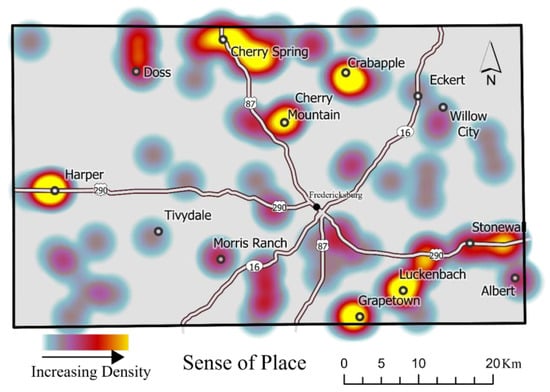
Figure 11.
Derivation of the Historic Small Towns zone. A density map of historic resources (excluding those in the Tourism Corridor) aligned with small ranching and farming communities and ghost towns.
4. Discussion
4.1. Multi-Dimensional Conservation Challenges and Opportunities
The geospatial inventory and spatial analysis presented here represent one of the most comprehensive assessments at the regional scale in terms of documenting the full suite of biophysical and cultural benefits. We used 20 different data sources to derive our inventory and a novel method to map existing and potential conservation easements and wildlife exemptions (i.e., processing and merging of county property records, tax rolls, and high-resolution land cover data). Our study demonstrates the use of a multi-dimensional inventory of ecosystem services in revealing conservation challenges and opportunities for working landscapes. For conservation and development planning, these maps convey concomitant benefits of nature and culture, a combination often overlooked by government officials, developers, and land use planners [6,12]. This oversight is particularly problematic in regions like Texas, where rural landscapes that have high value for the entire state population are being sacrificed for the profit of a few people [12,30]. By displaying the locations and spatial qualities of these benefits, this mapping approach provides an avenue for awareness and insights into future conservation challenges and opportunities. Mapping results made possible an examination of spatial variation and patterns of overlap across the county, where an in-depth place knowledge contributed to the identification of conservation targets [51]. Our analyses of a working ranch and regional conservation target zones highlight issues of local importance but also inform broader conservation and planning applications.
4.1.1. Tourism
Tourism has considerable impacts on landscapes and society [52]. In our study area of the Texas Hill Country, wine tourism has a dominating presence [35], overshadowing many attractions traditionally associated with Gillespie County. While agrotourism usually receives praise for its economic benefits [53], we found that some industries have the potential to impact key ecosystem services. Wine, in particular, is concerning for the anticipated challenges associated with the flourishing industry and potential opportunities for leveraging protections [54]. Since cultural benefit values were highest in the Tourism Corridor, wine’s influence is concerning for the future of aesthetics, sense of place, and tourism benefits. Concerns include the displacement of traditional land uses (e.g., peach orchards, working ranches), a loss of scenic quality, and visitor experiences becoming inauthentic. If these threats impact the cultural landscape benefits, they fare ill from an ecological perspective as well. Examining the previous conditions, distribution, adaptations, and present concerns can help illuminate the path to maintaining the benefits of agrotourism [26,55].
Agrotourism in this region began with peach orchards planted in the 1920s, long before the first winery. Though some early settlers cultivated personal vines, commercial wine arrived on the landscape in the 1970s with a focus on Rieslings (aligned with the area’s German heritage) but was largely unsuccessful. Wine broke through in the 1990s, when growers improved their varietal selections, helping to initiate the flourishing industry now present in the Hill Country [35,56]. A major difference between the peach orchards and vineyards of the Texas Hill Country is their function. Most of the wineries are tasting showrooms and entertainment facilities with a few vines on site. The majority of vineyards visible from major roads are planted merely for show, which aligns with the fact that many wineries source grapes from the Texas Panhandle or California [35,56,57].
The wine agrotourism industry has been an economic boom for the Texas Hill Country, occurring alongside the expansion of hotels, RV parks, second homes, short-term vacation rentals, and accompanying commercial development [35]. These land use changes reduce working lands both directly and indirectly. In addition to losing the working ranch where development occurs, this landscape transformation increases nearby land values. The increase in property values is an incentive for the landowner to sell or subdivide their property or can force the landowner to sell because they cannot afford the higher property taxes. What results is a positive feedback cycle where working lands are increasingly lost to development incentives and pressures. This process is happening all across Texas [10] and has accelerated to the point where Texas is losing more than 400 hectares of working lands every day [30].
The loss of working lands is consequential to the sustainability of wine and other tourism industries because the same intensive development that threatens working lands and traditional land uses also impacts the cultural benefits that tourists demand. Scenery is an obvious benefit for wine tourism, but an authentic sense of place is also an intrinsic part of tourism [35]. Indeed, the food and drink experience for a tourist is a presentation of history, place, and heritage [54,58]. Conservation of these elements is vital for the tourist experience to remain authentic.
In addition to the loss of cultural benefits, widespread residential and commercial development is causing costly impacts to provisioning and regulating ecosystem service benefits. The loss of 400 ha/day of working lands costs the state of Texas approximately USD 32 M/year in agricultural commodities, USD 128 M/year in water supplies, and USD 176 M/year in flood mitigation [30], not to mention many other valuable ecosystem services [12]. While agricultural landscapes are not as beneficial as natural landscapes in terms of most ecosystem services, they provide more landscape benefits than widespread development. Thus, the conservation of scenic landscapes and other cultural resources incidentally extends protections to many other benefits, including habitat, pollination, water quantity/quality, flood mitigation, climate and air quality regulation, and soil protection.
4.1.2. Protecting Land for Water
One of the defining features of Gillespie County and the Texas Hill Country is the Pedernales River [48,59]. We found that the highest sum (or overlap values) of provisioning, regulating, and cultural benefits all followed the Pedernales River (Figure 6). While cultural and provisioning benefits were concentrated in the lower river reach in the southeast quarter of the county, the regulating benefits of soil protection, water quality, and flood control were highest in the southwest quarter of the county, which coincides with the uppermost headwaters of the Pedernales River (Figure 9). This relatively high concentration of regulating benefits results from the lack of development and intact vegetation. Because of their greater connectivity to surrounding land uses, the headwaters of rivers have a disproportionate importance on water quantity and quality [60,61]. Thus, protecting the land around headwaters should be a priority in conservation and land use planning.
The benefits of protecting the headwaters of the Pedernales River extend well beyond Gillespie County. The Pedernales River flows into Lake Travis and makes up about a quarter of its total inflow [48,62]. Lake Travis is the main water supply for the million people who live in Austin and also contributes downstream flows to the Colorado River, which supplies irrigation and industrial water for many operations. After the multitude of uses, the remainder of this Pedernales Watershed runoff supports the coastal aquatic ecosystems of Matagorda Bay. The overall value of ecosystem services provided by water from the Pedernales River is beyond the scope of our study but is likely worth billions of dollars annually [63].
4.1.3. Heritage Hubs
As opposed to the other conservation target zones, Historic Small Towns is a non-contiguous zone that contains hubs of high cultural values, particularly sense of place. We use the term “hub” purposefully to indicate that these concentrated zones of heritage support the broader landscape [13]. One such historic Texas town in Gillespie County is Luckenbach, made famous by country music artists Waylon Jennings (in 1977), Willie Nelson (in the 1990s), and Miranda Lambert (in 2024). The remnants of what was once a ghost town have been famously preserved and repurposed into a popular music venue also known for its German-Texan heritage and 500-year-old live oak trees. Luckenbach is now a private business—a destination that sells an experience of a historic town with the trappings of its early days frozen in time. Although this is not the ideal outcome for all historic small towns, it does provide an example of conservation potential harnessed from historical resources.
Despite the successes in preserving the heritage of a historic town, Luckenbach has become embattled with threats from future development [64]. Part of its appeal is its authenticity and rural setting, but this sense of place and scenery diminishes as the surrounding area becomes developed. Much like natural resources in these landscapes, many cultural resources are on private lands and vulnerable to development. The stewardship of both is passed on when land is sold or inherited. This is especially relevant as Texas is facing the largest intergenerational land transfer in its history [10]. Historical resources can remain in a family for generations, but many are lost when land is sold or gradually subdivided. There are roadside historical markers in Gillespie County that reference large historic ranches that have since been subdivided into several private parcels, with little evidence of the history remaining. This outcome presents a concern for historical resources in working landscapes that are under development pressure.
As with natural resources, preserving historical resources is much less difficult than restoring them. What appears to have been successful with the current inventory is community ownership. Historical societies, church organizations, and non-profits own many of the parcels with intact historical designations. Another point of leverage for conservation may be in the interconnected stories, families, and events that historical resources often reference. For communities and landowners interested in preserving this part of the landscape, the current inventory can be used to expand and integrate historical resources that do not have designation into the ones that do. One of the challenges in historical conservation is funding for preservation. Unlike the private exploitation of resources seen in Luckenbach for tourism, the same economic success from tourism cannot be expected for all historical resources.
4.1.4. Working (Ranches) for Conservation?
The history and narrative of events at the Hershey Ranch highlight several aspects of multi-dimensional conservation priorities and vulnerabilities. For ranches and farms, conservation easements provide an option that allows the land to stay in family hands while keeping it from being divided or developed. These easements are usually established by conservation land trusts, which is the case for Hershey Ranch, but some are purchased by public entities. The City of Austin, for example, has acquired conservation easements to protect water resources and habitat for protected species [65]. Mitigation banks (via water quality protection) and conservation banks (via endangered species protection) can also contribute to public and private conservation [66,67]. These compliance markets require the developer to offset or mitigate environmental damage caused by their operations. For a local example relevant to Hershey Ranch, Kinder Morgan’s construction of the Permian Highway Pipeline was mitigated by a purchase of land that expanded Balcones Canyonlands National Wildlife Refuge.
While not permanent like conservation easements and mitigation banks, grant-assisted programs, like those used by Hersey Ranch, promote the protection of natural resources and are available to private landowners. Many of these, such as the Texas Landowner Incentive Program (LIP), help distribute funding and partner with the U.S. Fish and Wildlife Service to promote habitat conservation [68]. The target of this program is specific to rare, threatened, or endangered species, and can be leveraged for multiple landscape benefits. For example, the Pedernales River springs salamander (Eurycea sp.) is one of the many species sensitive to changes in water quality and riparian vegetation. With funding from Texas LIP, landowners cost-share improvement projects that target habitat, water quality, and flood control. Conservation easements, mitigation banks, Texas LIP, and other grant programs provide potential tools for protecting natural and cultural resources.
Working ranches like Hershey Ranch hold a lot of potential for conservation, but unfortunately, the same characteristics that are ideal for conservation (i.e., large intact areas with one landowner) make it a target for utility companies. In a state like Texas, which only allows development moratoriums when there are not adequate public facilities, utility companies have been given the power of eminent domain for their web of pipelines and transmission lines. Even though it has a perpetual conservation easement that is supposed to prevent development, Hershey Ranch has twice been the victim of eminent domain, once for an electric transmission line and once for a natural gas pipeline. Electric utility companies are regulated by PUCT, which requires a public process for eminent domain proceedings that involves recourse and negotiations. Accordingly, Hershey Ranch representatives were able to negotiate the route of the electric transmission to mitigate environmental damage. Oil and gas companies in Texas are not held to the same standard and are not required to negotiate with landowners. Despite their best efforts to minimize the impact of Kinder Morgan’s Permian Highway Pipeline, Hershey Ranch was powerless in preventing the energy company from clearing a 150 m pipeline path that not only destroyed wildlife habitat but further degraded it through fragmentation. This regulatory disparity has become a contentious issue due to its impact on protected lands and the rights of landowners [69]. The experiences of Hershey Ranch show that protected areas in Gillespie County and Texas are not as secure as their protected status suggests.
As working lands are increasingly sold and subdivided, working ranches are becoming surrounded by smaller tract subdivisions [10]. This land use change makes the remaining working ranches even more vulnerable to eminent domain condemnations because of (1) the utility companies’ preference for routing infrastructure through large intact tracts with one landowner and one lawyer, and (2) the increased demand for more energy and infrastructure from widespread development. While Texas is adding to its inventory of conservation lands, the increase in protected areas is not keeping pace with sprawling development [10,70].
4.2. Context, Cautions, and Limitations
The many provisioning, regulating, and cultural benefits that we inventoried and mapped for working landscapes present a duality. Our study found spatially explicit conservation opportunities for valuable working lands, but our findings could also be used as maps of potential development pressures [71]. Put another way, the natural and cultural resources that have the highest conservation priority are the same desirable amenities for real estate investors, developers, and the tourism industry. In Figure 6, for example, the high overlap values of the lower Pedernales River in Eastern Gillespie County make this a target zone for conservation, but this is the same region that is currently under the highest development pressures. The dilemma we presented in Section 4.1.1 on how this “authentic” region for wine tourism is losing its authenticity presents another duality. We realize that tourism brings development, but in this case, protecting tourism benefits is likely the best opportunity to protect the working landscape from more intensive types of development [72].
On the other end of the spectrum of benefit layer overlap value was the northeast corner of Gillespie County—the Geologic Significance conservation target zone. This area lacked most of the provisioning, regulating, and cultural benefits of the working landscape of the rest of the county. This lack of benefits, however, must be placed within the context of our perspective and methodology. Our inventory reflects ecosystem services that have direct benefits to humans. The unique geology and ecology of the Llano Uplift, which was mapped as only one benefit, probably has more value than all the other benefit layers combined. Thus, the number of benefits should not be the deciding factor in conservation priorities. Sometimes the lower value lands provide the best opportunities for conservation [73]. Case in point, the most recent protected area in Gillespie County is a 255-hectare property in our Geologic Significance zone, which the Texas Parks and Wildlife Department purchased to expand the Enchanted Rock State Natural Area and prevent the construction of a residential subdivision with hundreds of homes.
Our research emphasized the importance of historical resources and heritage values, aspects of conservation that do not receive as much attention as natural areas and biodiversity [13,38]. We attempted to capture sense of place with our inventory of historical resources, but we acknowledge that sense of place is difficult to capture on a map [18] and would require more labor-intensive means of assessing local relational values [19,20]. The dynamics of social–ecological systems are region-specific [20,21], and thus we concede that the relationships we discovered may not apply to other regions, states, or countries. We hope that our research inspires future studies that better capture the complex environmental history of working landscapes and the social–ecological systems they support.
Finally, we acknowledge that our study focused on nature’s contributions to people [17,18,19,20] using a geospatial inventory of benefits and did not consider other components of the social–ecological system, such as resource limitations, financial assets, institutions, governance, and demographics [21,74]. These components, particularly institutions and their rules/norms, can constrain or enable behaviors related to conservation and development. Institutions can also foster co-production of knowledge/management and help mediate relationships between nature and people [74]. For conservation planning, all of the social–ecological system components need to be considered.
5. Conclusions
The results of this study reveal multi-dimensional conservation issues of local importance to rural communities (which are disappearing), regional importance for the Texas Hill Country (which is suffering from dire water shortages), and global importance for working landscapes (which are being sacrificed for profitable developments). We realize the entire landscape cannot be conserved, so we offer a map (Figure 7) to help prioritize certain areas for certain purposes. Given the critical need for water, especially in Texas, headwaters should be prioritized for protection. Unique geological features such as the Llano Uplift are also irreplaceable. It is impossible to stop development along the tourism corridor, but it is necessary to preserve some of the scenic and cultural resources on which the tourism industry relies. Finally, the footprint of historic small towns may seem small and isolated, but they hold immeasurable value in the working landscapes’ sense of place and broader regional identity. Luckenbach, for example, is a “state of mind”.
As population grows and development expands, demographic and land ownership trends will pose challenges for conservation. Texas is set to face the largest intergenerational land transfer to date, and a new generation of owners is certain to bring changes [75]. This new generation might lack a connection with the land, historical knowledge of land use, or the ability to maintain the land once inherited. The popularity of rural land ownership, often as a second home, has also been increasing across North America, Europe, Australia, and New Zealand. As the rural landscape has become divided among more landowners, the median operation size is becoming smaller. Small farms and ranches (less than 200 ha) have seen a greater increase than any other operation size from 1997 to 2012 [10]. Profitability tends to decline with operation size and precede land subdivision [10]. The convergence of these trends is concerning because of parcelization’s reinforcing negative impacts on two interdependent factors: ecosystem services and conservation potential. A fragmented landscape increases the urgency for conservation and, with far more owners, makes coordinated efforts more difficult. As development pressure and fragmentation rise, a broad inventory of landscape benefits can help communities meet the growing challenges.
Though the presence of landscape benefits may differ and vary across space and time, the approach demonstrated in this county case study can be adapted to other regions and scales. As urbanization continues to accelerate across the globe [76], more and more places will face processes and threats identified in this case study. Regional-scale inventories provide a level of detail useful for local planning, but a similar approach can be adapted for broader scales. This study advances conservation as a tool for planners and policymakers for integrating a broad set of benefits into land use decisions. Rather than leaving the fate of the rural landscape to the economic forces driving development, this integrative approach can help to ensure that future generations experience the benefits of its cultural and natural landscapes.
Author Contributions
Conceptualization, J.P.J. and J.W.; methodology, J.W. and J.P.J.; software, J.W.; validation, J.W.; formal analysis, J.W.; investigation, J.W.; resources, J.W.; data curation, J.W.; writing—original draft preparation, J.W. and J.P.J.; writing—review and editing, J.P.J. and J.W.; visualization, J.W.; supervision, J.P.J.; project administration, J.P.J. and J.W. All authors have read and agreed to the published version of the manuscript.
Funding
This research received no external funding.
Data Availability Statement
The original contributions presented in this study are included in the article or Appendix A. All publicly available datasets have been referenced with website links provided. Further inquiries can be directed to the corresponding author.
Acknowledgments
We thank Andrew Sansom for his local knowledge and access to Hershey Ranch. Nathan Currit provided advice on research design. We also thank the four anonymous reviewers for their suggestions to improve the manuscripts.
Conflicts of Interest
The authors declare no conflicts of interest.
Appendix A
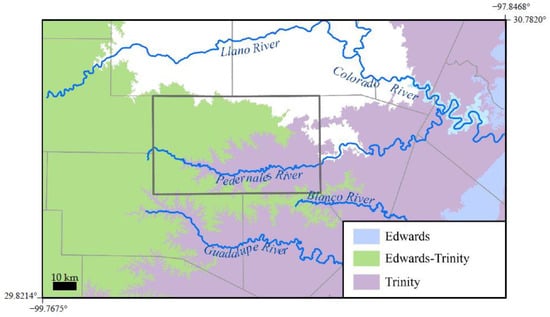
Figure A1.
Gillespie County (center bold outline) and surrounding major aquifers and rivers.
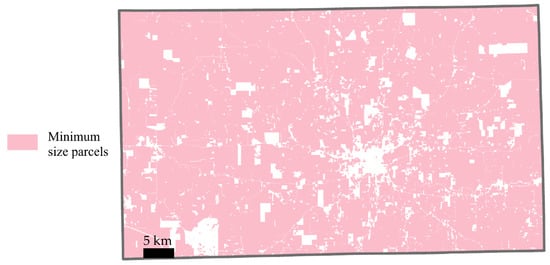
Figure A2.
Parcels over 8 ha in area (2021) for 2750 km2 Gillespie County, Texas (USA).
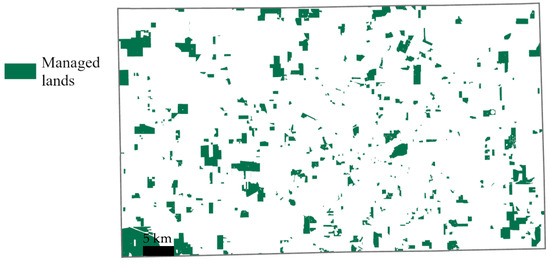
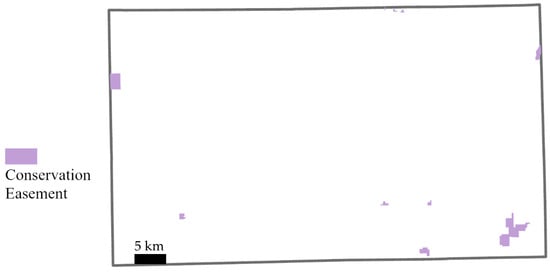
Figure A4.
Gillespie County conservation easements mapped from property records.
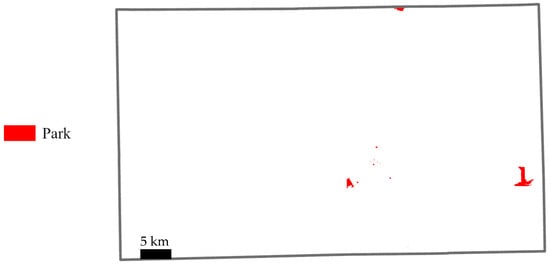
Figure A5.
Gillespie County parks mapped from PAD-US 2.1 and used as a sublayer in recreation and habitat benefit maps.
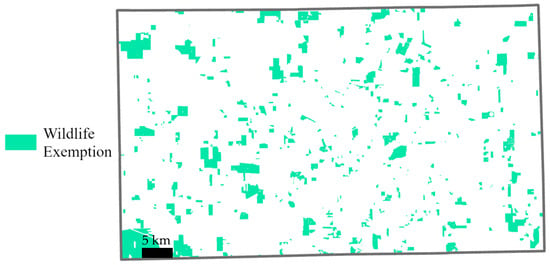
Figure A6.
Gillespie County parcels appraised for wildlife use (2021).
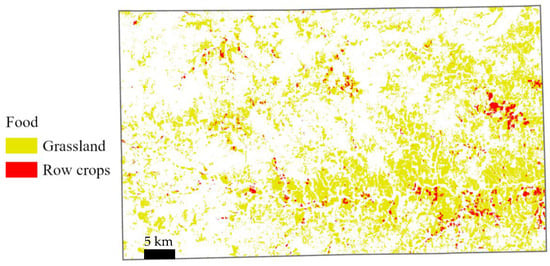
Figure A7.
Gillespie County food and fiber sublayers based on EMST land classification.
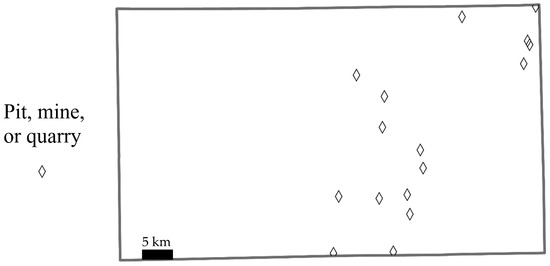
Figure A8.
Gillespie County mineral extraction sites used to map raw materials benefits.
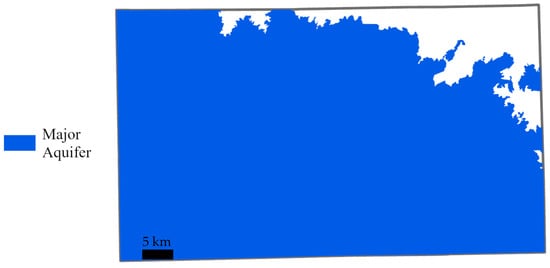
Figure A9.
Gillespie County major aquifer access.
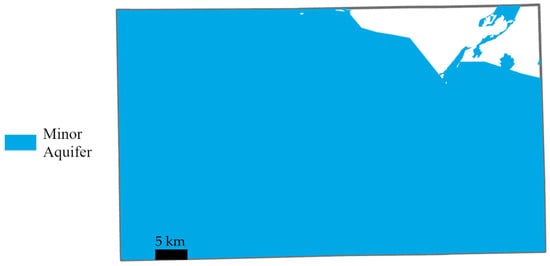
Figure A10.
Gillespie County minor aquifer access.
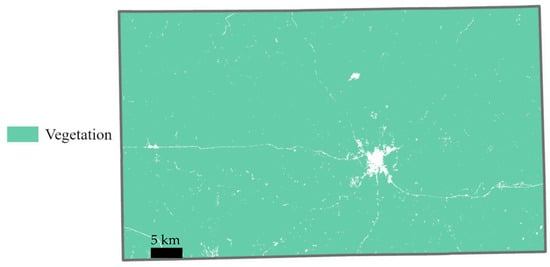
Figure A11.
All vegetated land covers in Gillespie County mapped from EMST data.
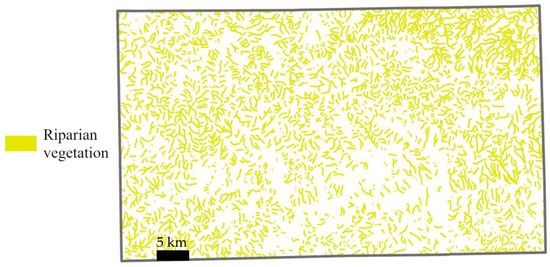
Figure A12.
All riparian vegetation in Gillespie County mapped from EMST data.
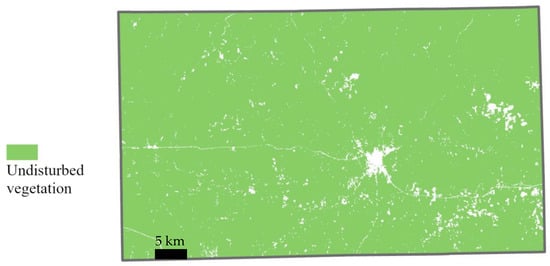
Figure A13.
Undisturbed vegetation (excludes row crops, water, barren, and grasslands described as disturbed) in Gillespie County.
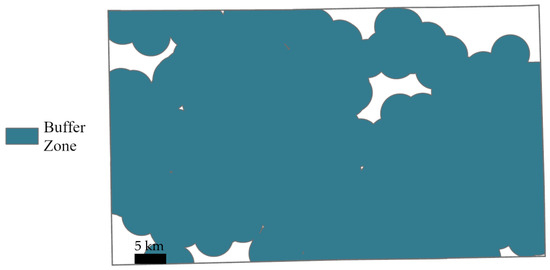
Figure A14.
Initial 3 km buffer around EMST row crops land class in Gillespie County.
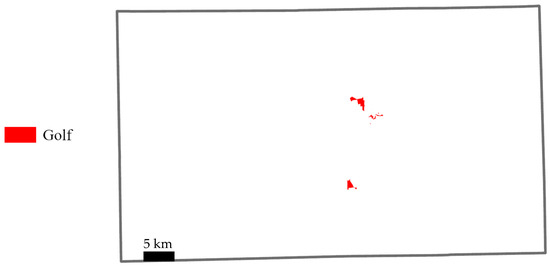
Figure A15.
Gillespie County golf parcels intersected using locations on Fredericksburg CVB website.
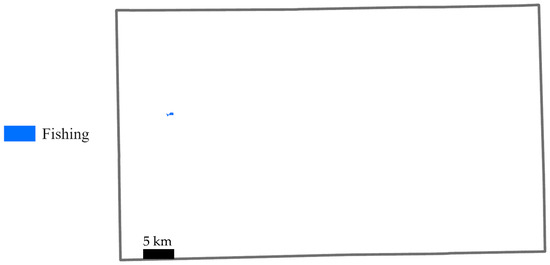
Figure A16.
Gillespie County fishing parcels intersected using locations listed Fredericksburg CVB website.

Figure A17.
Area visible in Gillespie County from major roads used to define scenic resources before removal of nonagricultural lands. The major highway in the county (US 290) crosses the center from west to east; see Figure 1.
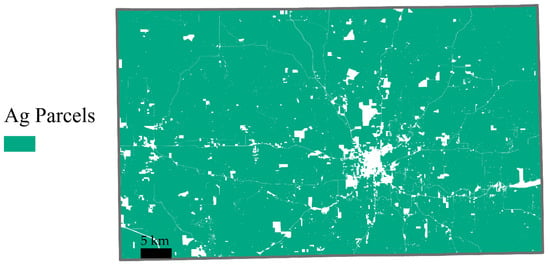
Figure A18.
Gillespie County parcels appraised as agricultural in 2021 and used to define scenic resources.
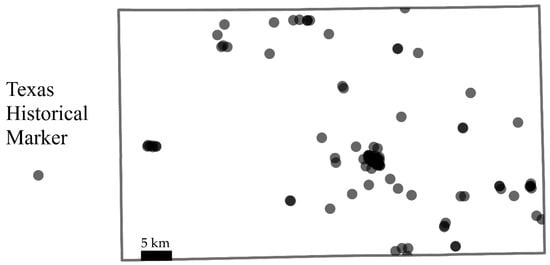
Figure A19.
Texas historical markers in Gillespie County from THC Atlas dataset.
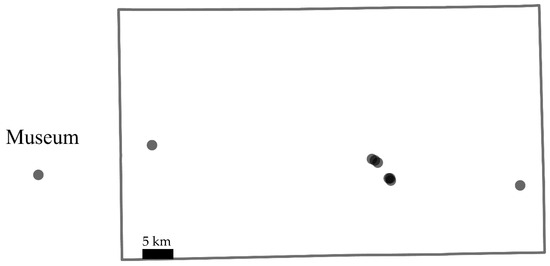
Figure A20.
Museum locations in Gillespie County from THC atlas dataset.
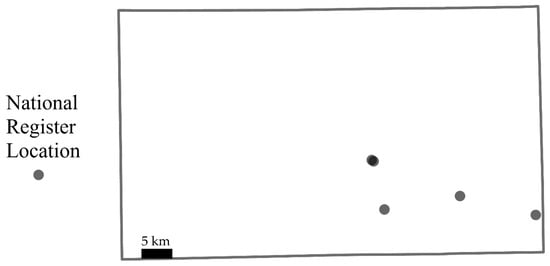
Figure A21.
National Register (NR) locations in Gillespie County from THC Atlas dataset.
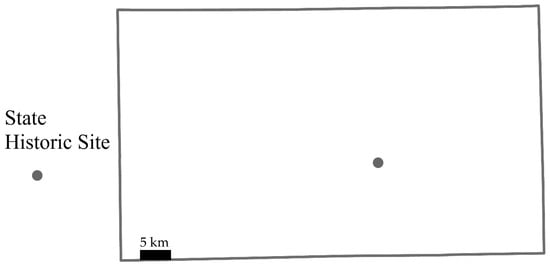
Figure A22.
State Historic Site in Gillespie County listed in THC Atlas Dataset.
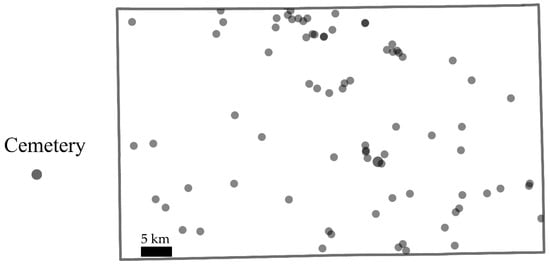
Figure A23.
Cemetery locations in Gillespie County mapped from THC Atlas Dataset.
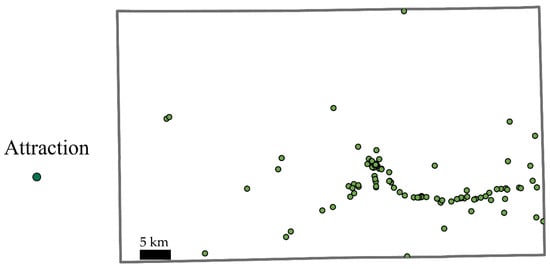
Figure A24.
Gillespie County tourist attraction locations on Fredericksburg CVB website.
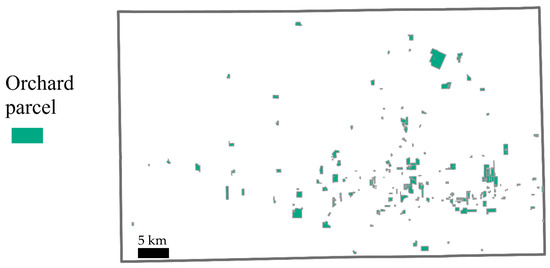
Figure A25.
Gillespie County parcels with an agricultural appraisal and orchard use description in 2021.
References
- DeFries, R.S.; Foley, J.A.; Asner, G.P. Land-use choices: Balancing human needs and ecosystem function. Front. Ecol. Environ. 2004, 2, 249–257. [Google Scholar] [CrossRef]
- Foley, J.A.; DeFries, R.; Asner, G.P.; Barford, C.; Bonan, G.; Carpenter, S.R.; Chapin, F.S.; Coe, M.T.; Daily, G.C.; Gibbs, H.K.; et al. Global Consequences of Land Use. Science 2005, 309, 570–574. [Google Scholar] [CrossRef]
- Bigelow, D.; Borchers, A. Major Uses of Land in the United States, 2012; 178, U.S.; Department of Agriculture, Economic Research Service: Washington, DC, USA, 2017. [Google Scholar] [CrossRef]
- Ramankutty, N.; Graumlich, L.; Achard, F.; Alves, D.; Chhabra, A.; DeFries, S.R.; Foley, A.J.; Geist, H.; Houghton, A.R.; Goldewijket, K.K.; et al. Global Land-Cover Change: Recent Progress, Remaining Challenges. In Land Use and Land Cover Change: Local Processes and Global Impacts; Geist, H., Lambin, F.E., Eds.; Springer: Berlin/Heidelberg, Germany, 2006; pp. 117–135. [Google Scholar] [CrossRef]
- Ramankutty, N.; Mehrabi, Z.; Waha, K.; Jarvis, L.; Kremen, C.; Herrero, M.; Rieseberg, L.H. Trends in Global Agricultural Land Use: Implications for Environmental Health and Food Security. Annu. Rev. Plant Biol. 2018, 69, 789–815. [Google Scholar] [CrossRef]
- Kremen, C.; Merenlender, A.M. Landscapes that work for biodiversity and people. Science 2018, 362, 6412. [Google Scholar] [CrossRef]
- Wilson, E.O. Half Earth: Our Planet’s Fight for Life; Liveright Publishing Corporation: New York, NY, USA, 2016. [Google Scholar]
- Trzyna, T. (Ed.) The Urban Imperative: Urban Outreach Strategies for Protected Area Agencies; InterEnvironment for IUCN: Sacramento, CA, USA, 2005; Available online: https://portals.iucn.org/library/sites/library/files/documents/PAPS-015.pdf (accessed on 1 November 2023).
- Gray, C.; Hill, S.; Newbold, T.; Hudson, L.N.; Borger, L.; Contu, S.; Hoskins, A.J.; Ferrier, S.; Purvis, A.; Scharlemann, J. Local biodiversity is higher inside than outside terrestrial protected areas worldwide. Nat. Commun. 2016, 7, 12306. [Google Scholar] [CrossRef] [PubMed]
- Smith, L.A.; Lopez, R.R.; Lund, A.A.; Wegner, B.N.; Cathey, J.C.; Lopez, A.; Anderson, R.E.; Powers, G.W.; Skow, K.L.; Crawford, M.A. Status Update and Trends of Texas Working Lands, 1997–2017; Texas A&M Natural Resources Institute: College Station, TX, USA, 2019. [Google Scholar]
- Coffin, A.W.; Sclater, V.; Swain, H.; Ponce-Campos, G.E.; Seymour, L. Ecosystem Services in Working Lands of the Southeastern USA. Front. Sustain. Food Syst. 2021, 5, 541590. [Google Scholar] [CrossRef]
- Putman, A.; Lopez, R.; Smith, L.; Uzquiano, J.; Lund, A.; Anderson, D.; Gan, J.; Ellis, C.; Roberts, J.; Kneuper, C.; et al. Texas Ecosystem Services: A statewide Assessment; Texas A&M Natural Resources Institute: College Station, TX, USA, 2022. [Google Scholar]
- Mitchell, N.J.; Barrett, B. Heritage Values and Agricultural Landscapes: Towards a New Synthesis. Landsc. Res. 2015, 40, 701–716. [Google Scholar] [CrossRef]
- Burkhard, B.; Kandziora, M.; Hou, Y.; Müller, F. Ecosystem Service Potentials, Flows and Demands—Concepts for Spatial Localisation, Indication and Quantification. Landsc. Online 2014, 34, 1–32. [Google Scholar] [CrossRef]
- Crossman, N.; Burkhard, B.; Nedkov, S.; Willemen, L.; Petz, K.; Palomo, I.; Drakou, E.G.; Martín-Lopez, B.; McPhearson, T.; Boyanova, K.; et al. A blueprint for mapping and modelling ecosystem services. Ecosyst. Serv. 2013, 4, 4–14. [Google Scholar] [CrossRef]
- Spiegal, S.; Bestelmeyer, B.T.; Archer, D.W.; Augustine, D.J.; Boughton, E.H.; Boughton, R.K.; Cavigelli, M.A.; Clark, P.E.; Derner, J.D.; Duncan, E.W.; et al. Evaluating strategies for sustainable intensification of US agriculture through the Long-Term Agroecosystem Research network. Environ. Res. Lett. 2018, 13, 034031. [Google Scholar] [CrossRef]
- Díaz, S.; Pascual, U.; Stenseke, M.; Martín-López, B.; Watson, R.; Molnár, Z.; Hill, R.; Chan, K.M.; Baste, I.A.; Brauman, K.A.; et al. Assessing nature’s contributions to people. Science 2018, 359, 270–272. [Google Scholar] [CrossRef]
- Chan, K.M.; Balvanera, P.; Benessaiah, K.; Chapman, M.; Díaz, S.; Gómez-Baggethun, E.; Turner, N. Why protect nature? Rethinking values and the environment. Proc. Nat. Acad. Sci. USA 2016, 113, 462–1465. [Google Scholar] [CrossRef]
- Pascual, U.; Balvanera, P.; Díaz, S.; Pataki, G.; Roth, E.; Stenseke, M.; Watson, R.T.; Dessane, E.B.; Islar, M.; Kelemen, E.; et al. Valuing nature’s contributions to people: The IPBES approach. Curr. Opin. Environ. Sustain. 2017, 26, 7–16. [Google Scholar] [CrossRef]
- Lopez, C.W.; Wade, M.T.; Julian, J.P. Nature-human relational models in a riverine social-ecological system: San Marcos River, Texas, USA. Geographies 2023, 3, 197–245. [Google Scholar] [CrossRef]
- Biggs, R.; De Vos, A.; Preiser, R.; Clements, H.; Maciejewski, K.; Schlüter, M. The Routledge Handbook of Research Methods for Social-Ecological Systems; Taylor & Francis: Abingdon, UK, 2021. [Google Scholar]
- Ogletree, S.; Powell, R.; Baldwin, R.; Leonard, P. A framework for mapping cultural resources in landscape conservation planning. Conserv. Sci. Pract. 2019, 1, e41. [Google Scholar] [CrossRef]
- Tengberg, A.; Fredholm, S.; Eliasson, I.; Knez, I.; Saltzman, K.; Wetterberg, O. Cultural ecosystem services provided by landscapes: Assessment of heritage values and identity. Ecosyst. Serv. 2012, 2, 14–26. [Google Scholar] [CrossRef]
- Xie, H.; Zhu, Z.; He, Y.; Zeng, X.; Wen, Y. Integrated framework of rural landscape research: Based on the global perspective. Landsc. Ecol. 2022, 37, 1161–1184. [Google Scholar] [CrossRef]
- Blocker, B. Cultural Landscapes, Historic Preservation, and Cattle Ranches: A New Protocol for Documenting & Preserving Working Cattle Ranches in Texas. Master’s Thesis, University of Texas-Arlington, Arlington, TX, USA, 2021. [Google Scholar]
- Willemen, L.; Jones, S.; Estrada Carmona, N.; DeClerck, F. Ecosystem service maps in agriculture. In Mapping Ecosystems Services; Burkhard, B., Maes, J., Eds.; Pensoft Publishers: Sofia, Bulgaria, 2017; pp. 319–323. [Google Scholar]
- U.S. Census Bureau. Texas Joins California as State with 30-Million-Plus Population. United States Department of Commerce. 2023. Available online: https://www.census.gov/library/stories/2023/03/texas-population-passes-the-30-million-mark-in-2022.html#:~:text=From%202000%20to%202022%2C%20the%20state%20gained%209%2C085%2C073%20residents%2C%20more,Nevada%2C%20Utah%2C%20and%20Idaho (accessed on 1 November 2023).
- U.S. Census Bureau. Top Fastest-Growing Cities. United States Department of Commerce. 2024. Available online: https://www.census.gov/library/visualizations/2024/comm/fastest-growing-cities.html (accessed on 16 May 2024).
- Kjelland, M.; Kreuter, U.; Clendenin, G.; Wilkins, R.; Wu, X.; Afanador, E.G.; Grant, W.E. Factors related to spatial patterns of rural land fragmentation in Texas. Environ. Manag. 2007, 40, 231–244. [Google Scholar] [CrossRef]
- Lund, A.A.; Smith, L.A.; Lopez, R.R. Texas Farm and Ranch Lands Conservation Program: 2024 Evaluation Report; Texas A&M Natural Resources Institute: College Station, TX, USA, 2024; Research Report Number 2024-1. [Google Scholar]
- U.S. Geological Survey (USGS) Gap Analysis Project (GAP). Protected Areas Database of the United States (PAD-US) 4.0. U.S. Geological Survey Data Release. 2024. Available online: https://doi.org/10.5066/P96WBCHS (accessed on 30 August 2024).
- Elliott, L.F.; Treuer-Kuehn, A.; Blodgett, C.F.; True, C.D.; German, D.; Diamond, D.D. Ecological Systems of Texas: 391 Mapped Types. Phase 1—6, 10-Meter Resolution Geodatabase, Interpretive Guides, and Technical Type Descriptions; Texas Parks & Wildlife Department and Texas Water Development Board: Austin, TX, USA, 2014; Available online: http://www.tpwd.state.tx.us/gis/data/downloads#EMS-T (accessed on 30 August 2024).
- Fredericksburg Convention and Visitors Bureau (CVB). Annual Report 2018. 2019. Available online: https://assets.simpleviewinc.com/simpleview/image/upload/v1/clients/fredericksburgtx/FCVB_551_Annual_Report_2018_r7_WEB_e57fba28-a3f5-48d6-b4e6-c4870904e52f.pdf (accessed on 10 November 2024).
- CBS Texas. Texas Ranks 2nd Most Visited Wine Region in the US. CBS News. 2023. Available online: https://www.cbsnews.com/texas/news/texas-ranks-2nd-most-visited-wine-region-in-the-u-s/ (accessed on 12 September 2023).
- Myles, C.C.; Townsend, C.G.; Collins, K. Texas in Transition: Considering the Production of Grapes, Wine, and Place. Soc. Sci. 2022, 11, 488. [Google Scholar] [CrossRef]
- Krausman, P.R.; Bleich, V.C.; Block, W.M.; Naugle, D.E.; Wallace, M.C. An assessment of rangeland activities on wildlife populations and habitats. In Conservation Benefits of Rangeland Practices: Assessment, Recommendations, and Knowledge Gaps; Briske, D.D., Ed.; U.S. Department of Agriculture, Natural Resources Conservation Service: Washington, DC, USA, 2011; Chapter 6; pp. 253–290. [Google Scholar]
- TEEB. The Economics of Ecosystems and Biodiversity: Mainstreaming the Economics of Nature: A Synthesis of the Approach, Conclusions and Recommendations of TEEB; United Nations Environment Programme: B’Kara, Malta, 2010. [Google Scholar]
- Julian, J.P. Old forts and new amenities in the Southern Plains. In Collateral Values: The Natural Capital Created by Landscapes of War; Lookingbill, T., Smallwood, P., Eds.; Springer: Cham, Switzerland, 2019; Chapter 4; pp. 77–109. [Google Scholar]
- U.S. Geological Survey. National Hydrography Dataset (NHD). Available online: https://www.usgs.gov/national-hydrography/national-hydrography-dataset (accessed on 30 January 2023).
- Texas Water Development Board (TWDB). GIS Data. Available online: https://www.twdb.texas.gov/mapping/gisdata.asp (accessed on 30 January 2023).
- U.S. Geological Survey. The National Map. Available online: https://www.usgs.gov/the-national-map-data-delivery/gis-data-download (accessed on 30 January 2023).
- U.S. Geological Survey (USGS). Mineral Resources Data System (MRDS). Available online: https://mrdata.usgs.gov/mrds/ (accessed on 30 August 2024).
- Texas Historical Commission (THC). Texas Historic Sites Atlas. Available online: https://atlas.thc.state.tx.us/ (accessed on 30 August 2024).
- Texas Department of Transportation. Roadway Inventory. Available online: https://www.txdot.gov/data-maps/roadway-inventory.html (accessed on 30 January 2023).
- Gillespie County Appraisal District (CAD). Gillespie CAD Certified Appraisal; Parcels 2021. Available online: https://gillespiecad.org/ (accessed on 30 January 2023).
- U.S. Department of Agriculture. National Agricultural Statistics Service, NASS—Quick Stats. 2017. Available online: https://www.nass.usda.gov/Quick_Stats/ (accessed on 30 January 2023).
- Hill Country Underground Water District. Gillespie County Regional Water Management Plan. 1995. Available online: https://www.twdb.texas.gov/publications/reports/contracted_reports/doc/93483369a.pdf (accessed on 1 May 2024).
- Wierman, D.A.; Butler, W.; Miller, M.; Zappitello, S.; Schwartz, B. How Much Water is in the Pedernales? The Meadows Center for Water and the Environment: San Marcos, TX, USA, 2015; p. 46. [Google Scholar]
- Ribbands, C. The Flight Range of the Honey-Bee. J. Anim. Ecol. 1951, 20, 220–226. [Google Scholar] [CrossRef]
- Griffith, G.E.; Bryce, S.B.; Omernik, J.M.; Rogers, A. Ecoregions of Texas; Texas Commission on Environmental Quality: Austin, Texas, USA, 2007; p. 125. [Google Scholar]
- Coenen, L.; Truffer, B. Places and Spaces of Sustainability Transitions: Geographical Contributions to an Emerging Research and Policy Field. Eur. Plan. Stud. 2012, 20, 367–374. [Google Scholar] [CrossRef]
- Gössling, S. Global environmental consequences of tourism. Glob. Environ. Change 2002, 12, 283–302. [Google Scholar] [CrossRef]
- Ammirato, S.; Felicetti, A.M.; Raso, C.; Pansera, B.A.; Violi, A. Agritourism and Sustainability: What We Can Learn from a Systematic Literature Review. Sustainability 2020, 12, 9575. [Google Scholar] [CrossRef]
- Myles, C.C. Fermented Landscapes: Lively Processes of Socio-Environmental Transformation; University of Nebraska Press: Lincoln, NE, USA, 2020. [Google Scholar]
- Okonkwo, E.; Odey, A. Impact of sustainability on tourism development in Nigeria: A case study of cross river state, Nigeria. Int. J. Tour. Sci. 2018, 18, 89–109. [Google Scholar] [CrossRef]
- LeBlanc, P. In Fredericksburg, tourists come for the wine, stay for the peaches. Austin American Statesman 2016. Available online: https://www.statesman.com/story/news/2016/09/23/in-fredericksburg-tourists-come-for-the-wine-stay-for-the-peaches/10104643007/ (accessed on 30 November 2024).
- Russell, R. What one should know about Texas wine. Shreveport Times 2021. Available online: https://www.shreveporttimes.com/story/life/columnists/2021/02/16/robert-russell-what-know-texas-wine/6757003002/ (accessed on 30 November 2024).
- Ellis, M. Implications for Resilience in the Cruise Tourism-Marine Protected Area Nexus in the Caribbean: The Case of St. Lucia. In Managing Crises in Tourism; Lewis-Cameron, A., Jordan, L.-A., Roberts, S., Eds.; Palgrave Macmillan: Cham, Switzerland, 2021; pp. 67–87. [Google Scholar] [CrossRef]
- Kramer, K. The Living Waters of Texas; Texas A&M University Press: College Station, TX, USA, 2010. [Google Scholar]
- Alexander, R.B.; Boyer, E.W.; Smith, R.A.; Schwarz, G.E.; Moore, R.B. The role of headwater streams in downstream water quality. J. Amer. Water Resour. Assoc. 2007, 43, 41–59. [Google Scholar] [CrossRef]
- Julian, J.P.; de Beurs, K.M.; Owsley, B.C.; Davies-Colley, R.J.; Ausseil, A.-G. River water quality changes in New Zealand over 26 years: Response to land use intensity. Hydrol. Earth Syst. Sci. 2017, 21, 1149–1171. [Google Scholar] [CrossRef]
- Hegemier, T. Making the Case for Source Water Protection: Pedernales River Basin Evaluation; Texas Hill Country Conservation Network: Austin, TX, USA, 2022; Available online: https://hillcountryalliance.org/wp-content/uploads/Source_Water_Report_2022_Single.pdf (accessed on 1 May 2024).
- de Groot, R.; Brander, L.; van der Ploeg, S.; Costanza, R.; Bernard, F.; Braat, L.; Christie, M.; Crossman, N.; Ghermandi, A.; Hein, L.; et al. Global estimates of the value of ecosystems and their services in monetary units. Ecosyst. Serv. 2012, 1, 50–61. [Google Scholar] [CrossRef]
- Wallace, C. Luckenbach is a Hill Country Treasure. Can it be saved? Texas Monthly 2022. Available online: https://www.texasmonthly.com/being-texan/can-luckenbach-be-saved/ (accessed on 30 November 2024).
- City of Austin. Water Quality Protection Lands Annual Report, FY. 2014. Available online: https://services.austintexas.gov/edims/document.cfm?id=240099 (accessed on 1 May 2024).
- McKenney, B.; Kiesecker, J. Policy development for biodiversity offsets: A review of offset frameworks. Environ. Manag. 2010, 45, 165–176. [Google Scholar] [CrossRef]
- Julian, J.P.; Weaver, R.C. Demand for Stream Mitigation in Colorado, USA. Water 2019, 11, 174. [Google Scholar] [CrossRef]
- Texas Parks & Wildlife Department (TPWD). Texas Landowner Incentive Program. Available online: https://tpwd.texas.gov/landwater/land/private/lip/ (accessed on 30 August 2024).
- Tread Coalition. Eminent Domain. Available online: https://treadcoalition.org/eminent-domain/ (accessed on 30 August 2024).
- Texas Land Trust Council. Texas Conservation Lands. Available online: https://texaslandtrustcouncil.org/ (accessed on 30 August 2024).
- Irwin, E.; Isserman, A.; Kilkenny, M.; Partridge, M. A century of research on rural development and regional issues. Am. J. Agric. Econ. 2010, 92, 522–553. [Google Scholar] [CrossRef]
- González-García, A.; Palomo, I.; González, J.; García-Díez, V.; García-Llorente, M.; Montes, C. Biodiversity and ecosystem services mapping: Can it reconcile urban and protected area planning? Sci. Total Environ. 2022, 803, 150048. [Google Scholar] [CrossRef] [PubMed]
- Knight, A.; Cowling, R. Embracing opportunism in the selection of priority conservation areas. Conserv. Biol. 2007, 21, 1124–1126. [Google Scholar] [CrossRef] [PubMed]
- Hill, R.; Díaz, S.; Pascual, U.; Stenseke, M.; Molnár, Z.; Van Velden, J. Nature’s contributions to people: Weaving plural perspectives. One Earth 2021, 4, 910–915. [Google Scholar] [CrossRef]
- Lund, A.; Smith, L.; Lopez, A.; Lopez, R. Texas Landowner Changes and Trends; Texas A&M Natural Resources Institute: College Station, TX, USA, 2017. [Google Scholar]
- Chen, G.; Li, X.; Liu, X. Global projections of future urban land expansion under shared socioeconomic pathways. Nat. Commun. 2020, 11, 537. [Google Scholar] [CrossRef]
Disclaimer/Publisher’s Note: The statements, opinions and data contained in all publications are solely those of the individual author(s) and contributor(s) and not of MDPI and/or the editor(s). MDPI and/or the editor(s) disclaim responsibility for any injury to people or property resulting from any ideas, methods, instructions or products referred to in the content. |
© 2025 by the authors. Licensee MDPI, Basel, Switzerland. This article is an open access article distributed under the terms and conditions of the Creative Commons Attribution (CC BY) license (https://creativecommons.org/licenses/by/4.0/).